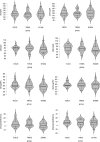Comparing transcranial direct current stimulation and transcranial random noise stimulation over left dorsolateral prefrontal cortex and left inferior frontal gyrus: Effects on divergent and convergent thinking
- PMID: 36405079
- PMCID: PMC9669420
- DOI: 10.3389/fnhum.2022.997445
Comparing transcranial direct current stimulation and transcranial random noise stimulation over left dorsolateral prefrontal cortex and left inferior frontal gyrus: Effects on divergent and convergent thinking
Abstract
The essential role of creativity has been highlighted in several human knowledge areas. Regarding the neural underpinnings of creativity, there is evidence about the role of left dorsolateral prefrontal cortex (DLPFC) and left inferior frontal gyrus (IFG) on divergent thinking (DT) and convergent thinking (CT). Transcranial stimulation studies suggest that the left DLPFC is associated with both DT and CT, whereas left IFG is more related to DT. However, none of the previous studies have targeted both hubs simultaneously and compared transcranial direct current stimulation (tDCS) and random noise stimulation (tRNS). Additionally, given the relationship between cognitive flexibility and creativity, we included it in order to check if the improvement in creativity may be mediated by cognitive flexibility. In this double-blind, between-subjects study, 66 healthy participants were randomly assigned to one of three groups (N = 22) that received a transcranial direct current stimulation (tDCS), transcranial random noise stimulation (tRNS), or sham for 20 min. The tDCS group received 1.5 mA with the anode over the left DLPFC and cathode over the left IFG. Locations in tRNS group were the same and they received 1.5 mA of high frequency tRNS (100-500 Hz). Divergent thinking was assessed before (baseline) and during stimulation with unusual uses (UU) and picture completion (PC) subtests from Torrance Creative thinking Test, whereas convergent thinking was evaluated with the remote association test (RAT). Stroop test was included to assess cognitive flexibility. ANCOVA results of performance under stimulation (controlling for baseline performance) showed that there were significant differences in PC (F = 3.35, p = 0.042, = 0.10) but not in UU (F = 0.61, p = 0.546) and RAT (F = 2.65, p = 0.079) scores. Post-hoc analyses showed that tRNS group had significantly higher scores compared to sham (p = 0.004) in PC. More specifically, tRNS showed higher performance in fluency (p = 0.012) and originality (p = 0.021) dimensions of PC compared to sham. Regarding cognitive flexibility, we did not find any significant effect of any of the stimulation groups (F = 0.34, p = 0.711). Therefore, no further mediation analyses were performed. Finally, the group that received tDCS reported more adverse effects than sham group (F = 3.46, p = 0.035). Altogether, these results suggest that tRNS may have some advantages over tDCS in DT.
Keywords: convergent thinking; divergent thinking; dorsolateral prefrontal cortex; inferior frontal gyrus; transcranial direct current stimulation; transcranial random noise stimulation.
Copyright © 2022 Peña, Sampedro, Balboa-Bandeira, Ibarretxe-Bilbao, Zubiaurre-Elorza, García-Guerrero and Ojeda.
Conflict of interest statement
The authors declare that the research was conducted in the absence of any commercial or financial relationships that could be construed as a potential conflict of interest.
Figures


Similar articles
-
Improvement in creativity after transcranial random noise stimulation (tRNS) over the left dorsolateral prefrontal cortex.Sci Rep. 2019 May 8;9(1):7116. doi: 10.1038/s41598-019-43626-4. Sci Rep. 2019. PMID: 31068654 Free PMC article. Clinical Trial.
-
Effects of transcranial direct current stimulation of left and right inferior frontal gyrus on creative divergent thinking are moderated by changes in inhibition control.Brain Struct Funct. 2020 Jul;225(6):1691-1704. doi: 10.1007/s00429-020-02081-y. Epub 2020 Jun 17. Brain Struct Funct. 2020. PMID: 32556475 Free PMC article.
-
The effect of transcranial random noise stimulation (tRNS) over bilateral posterior parietal cortex on divergent and convergent thinking.Sci Rep. 2020 Sep 23;10(1):15559. doi: 10.1038/s41598-020-72532-3. Sci Rep. 2020. PMID: 32968171 Free PMC article.
-
Neurobiological Effects of Transcranial Direct Current Stimulation over the Inferior Frontal Gyrus: A Systematic Review on Cognitive Enhancement in Healthy and Neurological Adults.Biomedicines. 2024 May 22;12(6):1146. doi: 10.3390/biomedicines12061146. Biomedicines. 2024. PMID: 38927353 Free PMC article. Review.
-
Uncorking the limitation-improving dual tasking using transcranial electrical stimulation and task training in the elderly: a systematic review.Front Aging Neurosci. 2024 Apr 8;16:1267307. doi: 10.3389/fnagi.2024.1267307. eCollection 2024. Front Aging Neurosci. 2024. PMID: 38650865 Free PMC article.
Cited by
-
Examining tolerability, safety, and blinding in 1032 transcranial electrical stimulation sessions for children and adolescents with neuropsychiatric and neurodevelopmental disorders.Sci Rep. 2025 Feb 7;15(1):4560. doi: 10.1038/s41598-025-88256-1. Sci Rep. 2025. PMID: 39915614 Free PMC article.
-
The effect of transcranial random noise stimulation (tRNS) over bilateral parietal cortex in visual cross-modal conflicts.Sci Rep. 2025 Feb 10;15(1):4980. doi: 10.1038/s41598-025-85682-z. Sci Rep. 2025. PMID: 39929857 Free PMC article. Clinical Trial.
-
Effects of online tDCS and hf-tRNS on reading performance in children and adolescents with developmental dyslexia: a study protocol for a cross sectional, within-subject, randomized, double-blind, and sham-controlled trial.Front Neurol. 2024 Mar 12;15:1338430. doi: 10.3389/fneur.2024.1338430. eCollection 2024. Front Neurol. 2024. PMID: 38533416 Free PMC article.
-
The impact of transcranial random noise stimulation (tRNS) on alpha coherence and verbal divergent thinking.Netw Neurosci. 2025 Apr 30;9(2):569-590. doi: 10.1162/netn_a_00446. eCollection 2025. Netw Neurosci. 2025. PMID: 40487366 Free PMC article.
-
The impact of internet pornography addiction on brain function: a functional near-infrared spectroscopy study.Front Hum Neurosci. 2025 Apr 16;19:1477914. doi: 10.3389/fnhum.2025.1477914. eCollection 2025. Front Hum Neurosci. 2025. PMID: 40309664 Free PMC article.
References
-
- Andrews S. C., Hoy K. E., Enticott P. G., Daskalakis Z. J., Fitzgerald P. B. (2011). Improving working memory: The effect of combining cognitive activity and anodal transcranial direct current stimulation to the left dorsolateral prefrontal cortex. Brain Stimul. 4 84–89. 10.1016/j.brs.2010.06.004 - DOI - PubMed
LinkOut - more resources
Full Text Sources

